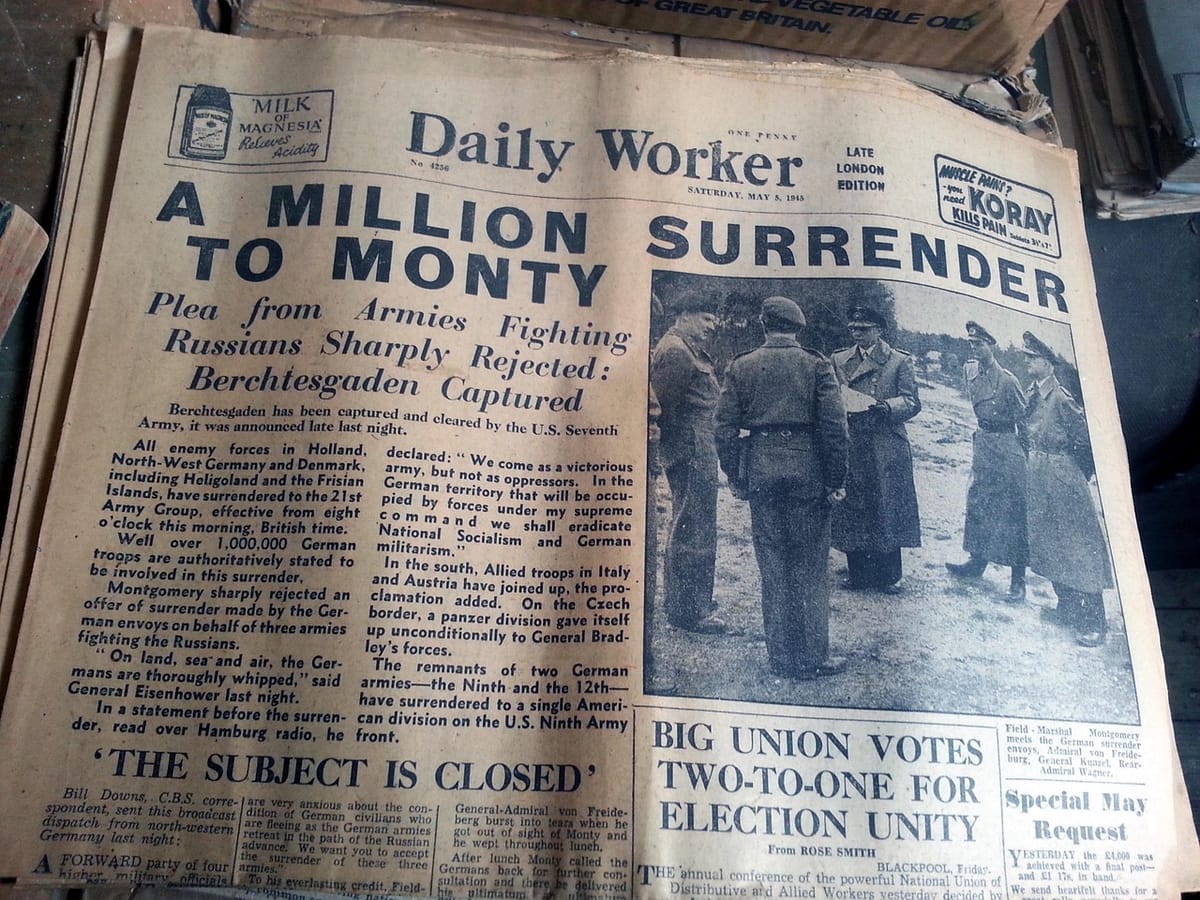
By Elke Porter | Canadian German Business News | May 9, 2025
On May 9, 1945, the German economy lay in ruins. Just one day earlier, Germany had signed its unconditional surrender, officially ending World War II in Europe. The surrender took place at Karlshorst, a district in Berlin, at the headquarters of the Soviet military administration. It was signed late in the evening on May 8 but due to time zone differences, the Soviet Union celebrated the end of the war on May 9. This moment marked not only the end of Nazi rule but also the collapse of the German state, infrastructure, and economy.
By that date, Germany had suffered six years of total war. Cities were flattened by Allied bombings—Dresden, Hamburg, Cologne, and large parts of Berlin were reduced to rubble. Industrial production had ground to a halt, transportation networks were shattered, and food supplies were dangerously low. Millions were homeless or displaced.
The Reichsmark, Germany’s currency, had little value, and barter systems often replaced official markets. With over 10 million German soldiers dead, missing, or captured, and millions of civilians killed or traumatized, Germany’s future appeared bleak.
On top of this, instead of demanding formal financial reparations after World War II, the Soviet Union took a different approach in its occupied zone of Germany. Entire factories were dismantled and shipped eastward to the USSR, along with trains, railroad tracks, machinery, tools, and raw materials. This systematic extraction of industrial assets was part of the Soviet plan to rebuild its own war-torn economy, having suffered immense losses during the conflict.
One striking example of this plundering was the widespread looting of personal valuables. It’s often said—half in jest, half in truth—that millions of German watches ended up on Soviet wrists. While watches were among the most visible spoils, the larger effect came from the removal of industrial capacity, which severely crippled the economic recovery of what would become East Germany.
Yet just four years later, in 1949, the foundations of a dramatic economic recovery—later known as the Wirtschaftswunder or “economic miracle”—were in place. Several key developments fueled this turnaround.
First, the Marshall Plan (European Recovery Program), initiated by the United States in 1948, injected capital and resources into West Germany, facilitating the rebuilding of infrastructure and the revival of industry. Second, the 1948 currency reform replaced the worthless Reichsmark with the Deutsche Mark, restoring confidence in the economy and ending rampant inflation. Third, Ludwig Erhard, the director of the Bizonal Economic Council and later Minister of Economics, introduced sweeping free-market reforms. His policies reduced price controls, encouraged competition, and liberated the labor market.
Also, in the aftermath of World War II, with millions of German men killed, missing, or held as prisoners of war, the burden of rebuilding the nation fell heavily on the shoulders of women. This period became known as the Stunde der Frauen—the “hour of the women.” Across the bombed-out cities of Germany, women rolled up their sleeves to clear rubble from streets, rebuild homes by hand, and take on jobs in factories, offices, and public services that had traditionally been held by men.
These “Trümmerfrauen” (rubble women) became a symbol of resilience and determination, playing a critical role in the country’s physical and moral recovery. At a time when the German economy was paralyzed and the future uncertain, it was often the unacknowledged labour and endurance of women that formed the foundation for Germany’s eventual rebirth.
By the time the Federal Republic of Germany (West Germany) was founded in May 1949, industrial production had already significantly increased, and exports were beginning to recover. The Cold War also accelerated economic development, as West Germany became a strategic partner of the West. East Germany, under Soviet control, experienced a much slower recovery.
The transformation from the devastation of May 1945 to the beginnings of prosperity in 1949 remains one of the most remarkable turnarounds in modern history, setting the stage for West Germany’s rise as an economic powerhouse in the decades to follow.
#Wirtschaftswunder #Germany 1945 #Post War Recovery #Economic Miracle #Marshall Plan #WWII History #German Economy #Rebuilding Germany #German Canadian Business News #Elke Porter
Connect with Elke at Westcoast German Media or on LinkedIn: Elke Porter or contact her on WhatsApp: +1 604 828 8788

